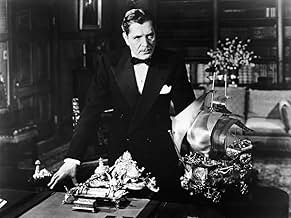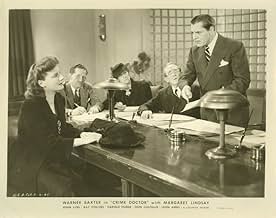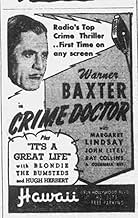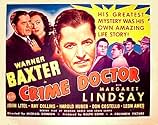CALIFICACIÓN DE IMDb
6.3/10
633
TU CALIFICACIÓN
Agrega una trama en tu idiomaAmnesia victim, Robert Ordway, becomes the country's leading criminal psychologist. After he is hit on the head by someone from his past, he suddenly remembers his previous life as a crimina... Leer todoAmnesia victim, Robert Ordway, becomes the country's leading criminal psychologist. After he is hit on the head by someone from his past, he suddenly remembers his previous life as a criminal.Amnesia victim, Robert Ordway, becomes the country's leading criminal psychologist. After he is hit on the head by someone from his past, he suddenly remembers his previous life as a criminal.
- Dirección
- Guionistas
- Elenco
Phil Arnold
- Third Reporter in Court
- (sin créditos)
Paul Bryar
- First Reporter in Court
- (sin créditos)
Wallis Clark
- Judge
- (sin créditos)
Chester Clute
- Headwaiter
- (sin créditos)
Kernan Cripps
- Turnkey
- (sin créditos)
Harold De Becker
- Bartender
- (sin créditos)
Franklyn Farnum
- Juror
- (sin créditos)
Opiniones destacadas
With the exception of the Rathbone and Bruce Sherlock Holmes series, this is quite possibly the best of the 'mystery' series of the 30s and 40s. The series begins with this movie as Phil Morgan, master criminal, is double crossed by his gang, beaten and dumped along a roadside. As a result, he suffers from amnesia. This movie, the first of the series, establishes The Crime Doctor's background, explains how and why he became a doctor (a psychiatrist, actually), head of the parole board and helped many convicts find the 'straight and narrow'.
The element that makes this movie and the series in general unique is that it relies on psychiatry and the tendencies of the mentally ill. They often tease you by inserting an obviously unbalanced person and although the plot may lead one to believe that person is the "perp" they may or may not be the actual "perp". Because psychiatry was relatively new and often misunderstood, it provided general insight to the subject. In many ways, the series has yet to become dated although the psychological concepts may appear to be fairly basic nowadays.
A series of factors make this movie series much more enjoyable than others such as The Lone Wolf, Boston Blackie or Bulldog Drummond. The first is the consistency. The quality of the stories in all ten movies remains high throughout the series where the stories of other series tend to deteriorate into standard potboilers after the studio has captured the audience's interest. Second, the same actor plays the lead character in all of the movies. Third, the quality of the supporting cast is exceptional throughout the series. Some of the more recognizable supporting cast includes John Litel, Ray Collins, Harold Huber, Barton MacLane, Jerome Cowan, Reginald Denny, Eduardo Ciannelli, Nina Foch, George Zucco, Ben Weldon, Hillary Brooke, William Frawley, Ellen Drew and last, but far from least, a very young Lois Maxwell who played Miss Moneypenny in at least 15 James Bond films.
However, over the six years the series was shot, one can easily see Baxter's health deteriorating.
The element that makes this movie and the series in general unique is that it relies on psychiatry and the tendencies of the mentally ill. They often tease you by inserting an obviously unbalanced person and although the plot may lead one to believe that person is the "perp" they may or may not be the actual "perp". Because psychiatry was relatively new and often misunderstood, it provided general insight to the subject. In many ways, the series has yet to become dated although the psychological concepts may appear to be fairly basic nowadays.
A series of factors make this movie series much more enjoyable than others such as The Lone Wolf, Boston Blackie or Bulldog Drummond. The first is the consistency. The quality of the stories in all ten movies remains high throughout the series where the stories of other series tend to deteriorate into standard potboilers after the studio has captured the audience's interest. Second, the same actor plays the lead character in all of the movies. Third, the quality of the supporting cast is exceptional throughout the series. Some of the more recognizable supporting cast includes John Litel, Ray Collins, Harold Huber, Barton MacLane, Jerome Cowan, Reginald Denny, Eduardo Ciannelli, Nina Foch, George Zucco, Ben Weldon, Hillary Brooke, William Frawley, Ellen Drew and last, but far from least, a very young Lois Maxwell who played Miss Moneypenny in at least 15 James Bond films.
However, over the six years the series was shot, one can easily see Baxter's health deteriorating.
When a man is thrown from a speeding car, he awakens without a clue who he is. It takes ten years for him to rehabilitate into the renowned "Dr. Ordway" (Warner Baxter), a man who ends up esteemed enough to be put in charge of the parole board. It's as he is making a broadcast that an inmate elsewhere (Dorothy Tree) recognises his voice and identifies criminal mastermind "Philip Morgan" - a man whose gang stole $200,000 that is still unaccounted for. It's not just her who has identified him, and pretty swiftly his erstwhile gang are also on his trail wanting their loot. "Ordway" realises that he still has some cards to play in his dealings with their leader "Caspair" (John Litel) that might just help him fully re-establish his identity and hopefully find the money. This is quite an engaging little mystery that allows Baxter to establish his character's credentials as a competent detective whilst using some elementary psychology, the odd shrug and a wry smile to provide us with a decently paced cat-and-mouse drama that presents our protagonist with a sort of lose-lose scenario towards the end. The production is adequate, the dialogue quite entertaining and it amiably sets the scene for more to come.
One of the wilder premises involving a movie series was in the Crime Doctor films that starred Warner Baxter. We are asked to believe that Baxter was once gentleman crook Phil Morgan who held out the loot from his gang and who slugged him and threw him from a moving car and left him for dead. He didn't die, but has a case of amnesia. In any event ten years go by and in those ten years we are asked to believe that Baxter has acquired the eduction and training to become criminal psychologist Robert Ordway a most respected gent.
The Crime Doctor character came from radio and I assume that radio provided a lot of background so that the Ordway character became more believable. Given the fact that the movie-going public had been used to the Crime Doctor radio program the whole premise was easier to swallow in 1943 than it is today.
Baxter who is now a successful criminal psychologist and engaged to Margaret Lindsay is visited by old gang member John Litel who wants to know where the stashed loot is. He's not buying the amnesia story. He assembles the rest of the gang and the film is a battle of wits between Baxter and the rest. Need I tell you who wins?
Future Crime Doctor films gradually left out the part that Baxter was a convict and as a result they have not become as dated and are more believable than the first film. Some are actually pretty good with the simple premise that Baxter with his psychological training is a pretty good criminologist, better in many cases than those who carry a badge. In fact Jeff Goldblum's character on Law and Order: Criminal Intent who does carry a badge can trace his origins back to Warner Baxter's Robert Ordway.
A good screen character with too much unbelievable baggage.
The Crime Doctor character came from radio and I assume that radio provided a lot of background so that the Ordway character became more believable. Given the fact that the movie-going public had been used to the Crime Doctor radio program the whole premise was easier to swallow in 1943 than it is today.
Baxter who is now a successful criminal psychologist and engaged to Margaret Lindsay is visited by old gang member John Litel who wants to know where the stashed loot is. He's not buying the amnesia story. He assembles the rest of the gang and the film is a battle of wits between Baxter and the rest. Need I tell you who wins?
Future Crime Doctor films gradually left out the part that Baxter was a convict and as a result they have not become as dated and are more believable than the first film. Some are actually pretty good with the simple premise that Baxter with his psychological training is a pretty good criminologist, better in many cases than those who carry a badge. In fact Jeff Goldblum's character on Law and Order: Criminal Intent who does carry a badge can trace his origins back to Warner Baxter's Robert Ordway.
A good screen character with too much unbelievable baggage.
It's odd that CRIME DOCTOR ('43), the film that started the B-film series at Columbia, is one of the least involving of the Dr. Ordway stories. The first half-hour is pretty dull before the film takes on any real interest in the amnesia background of Baxter's character.
His development from complete amnesia to gradual recall is well handled and some of the scenes with JOHN LITEL have a certain amount of interest, but the story lacks overall believability with RAY COLLINS turning to the phone book in a search for Baxter's name and then becoming his mentor and leading him into a doctor's career with a quick montage of events establishing Baxter as a psychiatrist.
MARGARET LINDSAY is attractive as the female interest, looking so much like a prettier version of Barbara Stanwyck, whom I always thought she resembled in manner and looks. For fans of the series, this one will do, but surprisingly it's not the sort of "first film in the series" that I expected and you have to wonder why Columbia decided to make a series after this one.
WARNER BAXTER looks quite ill in most of his close-ups, so you can see the man was in fragile health all during these "Crime Doctor" films. He gives his usual solid performance but the film was a disappointment for me.
His development from complete amnesia to gradual recall is well handled and some of the scenes with JOHN LITEL have a certain amount of interest, but the story lacks overall believability with RAY COLLINS turning to the phone book in a search for Baxter's name and then becoming his mentor and leading him into a doctor's career with a quick montage of events establishing Baxter as a psychiatrist.
MARGARET LINDSAY is attractive as the female interest, looking so much like a prettier version of Barbara Stanwyck, whom I always thought she resembled in manner and looks. For fans of the series, this one will do, but surprisingly it's not the sort of "first film in the series" that I expected and you have to wonder why Columbia decided to make a series after this one.
WARNER BAXTER looks quite ill in most of his close-ups, so you can see the man was in fragile health all during these "Crime Doctor" films. He gives his usual solid performance but the film was a disappointment for me.
... as well as the Great Depression as a two front war with everything at stake yields bigger fish to fry. This is what this first film in the Crime Doctor crime/mystery series represents in the person of Dr. Robert Ordway (Warner Baxter).
The movie opens with a car speeding along the road with a sign referring to the presidential campaign of 1932. The car slows down and an unconscious man is dumped from the vehicle that then speeds off again. Next we see the man without an identity recovering in the hospital with no memory of who he was before. The nurses dub the mystery man Robert Ordway after the wing of the hospital in which he is staying. Kindly Dr. John Carey (Ray Collins) works with Ordway after he is discharged to help him recover his memory, but no association -not even going through the phone book name by name - yields results. A check of his fingerprints with police records also turns up nothing. Of course, all that proves is that Ordway was clever enough to never be arrested, not that he wasn't a criminal. With all of the time he's spent with the good doctor, Ordway has developed an interest in medicine, and with he and Dr. Carey agreeing that the unmasking of his identity is something that he should no longer hope to have solved in the near future, he decides to study medicine himself and specialize in psychiatry.
So Ordway starts out as a freshman in college in his early 30's, with his studies requiring the next ten years of his life. The world changes a great deal in the next ten years - Prohibition ends, the Depression eases, and World War II begins. In all this time Ordway is no closer to recovering his identity. As he begins to practice medicine, he spends a great deal of time working with convicts at the prison. He's drawn here because he wants to do some good but also because he hopes that someone there will recognize him and help him reclaim his memory. In the back of his mind he's got to know that nobody gets dumped as he did from a speeding automobile in 1932 without the high probability that he was somehow mixed up in crime.
There's a complicating factor too. Ordway has become involved with an attractive young woman who works with female ex-cons - Grace Fielding (Margaret Lindsay). At this point, Ordway doesn't even know if he has a wife out there somewhere, so he can't make plans with Grace until he knows his true marital status. How will all of this work out? Watch and find out.
This first in the series was probably never intended to be anything other than just one film, so this movie wraps up in a self-contained kind of way that will leave you wondering what ever happened to this or that character if you watch the whole series. It was a big hit, so Columbia released a whole series featuring the Dr. Robert Ordway character, always starring Warner Baxter, over the next seven years. The rest of the series focuses not so much on Ordway's life as it does on some mystery Ordway has wandered into and how he solves it, but in this first film the mystery is Ordway himself. Who is he really? And if he recovers his memory and the news is bad - will remembering alone make him a criminal all over again? Does a man need a clean slate of a mind to really have a clean slate? Interesting material done in the quick spartan way required by poverty row Columbia's budget, but done well all the same.
The movie opens with a car speeding along the road with a sign referring to the presidential campaign of 1932. The car slows down and an unconscious man is dumped from the vehicle that then speeds off again. Next we see the man without an identity recovering in the hospital with no memory of who he was before. The nurses dub the mystery man Robert Ordway after the wing of the hospital in which he is staying. Kindly Dr. John Carey (Ray Collins) works with Ordway after he is discharged to help him recover his memory, but no association -not even going through the phone book name by name - yields results. A check of his fingerprints with police records also turns up nothing. Of course, all that proves is that Ordway was clever enough to never be arrested, not that he wasn't a criminal. With all of the time he's spent with the good doctor, Ordway has developed an interest in medicine, and with he and Dr. Carey agreeing that the unmasking of his identity is something that he should no longer hope to have solved in the near future, he decides to study medicine himself and specialize in psychiatry.
So Ordway starts out as a freshman in college in his early 30's, with his studies requiring the next ten years of his life. The world changes a great deal in the next ten years - Prohibition ends, the Depression eases, and World War II begins. In all this time Ordway is no closer to recovering his identity. As he begins to practice medicine, he spends a great deal of time working with convicts at the prison. He's drawn here because he wants to do some good but also because he hopes that someone there will recognize him and help him reclaim his memory. In the back of his mind he's got to know that nobody gets dumped as he did from a speeding automobile in 1932 without the high probability that he was somehow mixed up in crime.
There's a complicating factor too. Ordway has become involved with an attractive young woman who works with female ex-cons - Grace Fielding (Margaret Lindsay). At this point, Ordway doesn't even know if he has a wife out there somewhere, so he can't make plans with Grace until he knows his true marital status. How will all of this work out? Watch and find out.
This first in the series was probably never intended to be anything other than just one film, so this movie wraps up in a self-contained kind of way that will leave you wondering what ever happened to this or that character if you watch the whole series. It was a big hit, so Columbia released a whole series featuring the Dr. Robert Ordway character, always starring Warner Baxter, over the next seven years. The rest of the series focuses not so much on Ordway's life as it does on some mystery Ordway has wandered into and how he solves it, but in this first film the mystery is Ordway himself. Who is he really? And if he recovers his memory and the news is bad - will remembering alone make him a criminal all over again? Does a man need a clean slate of a mind to really have a clean slate? Interesting material done in the quick spartan way required by poverty row Columbia's budget, but done well all the same.
¿Sabías que…?
- TriviaRay Collins, who plays Dr. Carey in this film, is one of several actors who played the title character in the "Crime Doctor" radio series.
- ConexionesFollowed by Médico del hampa (1943)
Selecciones populares
Inicia sesión para calificar y agrega a la lista de videos para obtener recomendaciones personalizadas
Detalles
- Fecha de lanzamiento
- País de origen
- Idioma
- También se conoce como
- Crime Doctor
- Locaciones de filmación
- Mulholland Drive, Hollywood Hills, Los Ángeles, California, Estados Unidos(Establishing shot.)
- Productora
- Ver más créditos de la compañía en IMDbPro
- Tiempo de ejecución1 hora 6 minutos
- Color
- Relación de aspecto
- 1.37 : 1
Contribuir a esta página
Sugiere una edición o agrega el contenido que falta

Principales brechas de datos
By what name was El oráculo del crimen (1943) officially released in Canada in English?
Responda





















